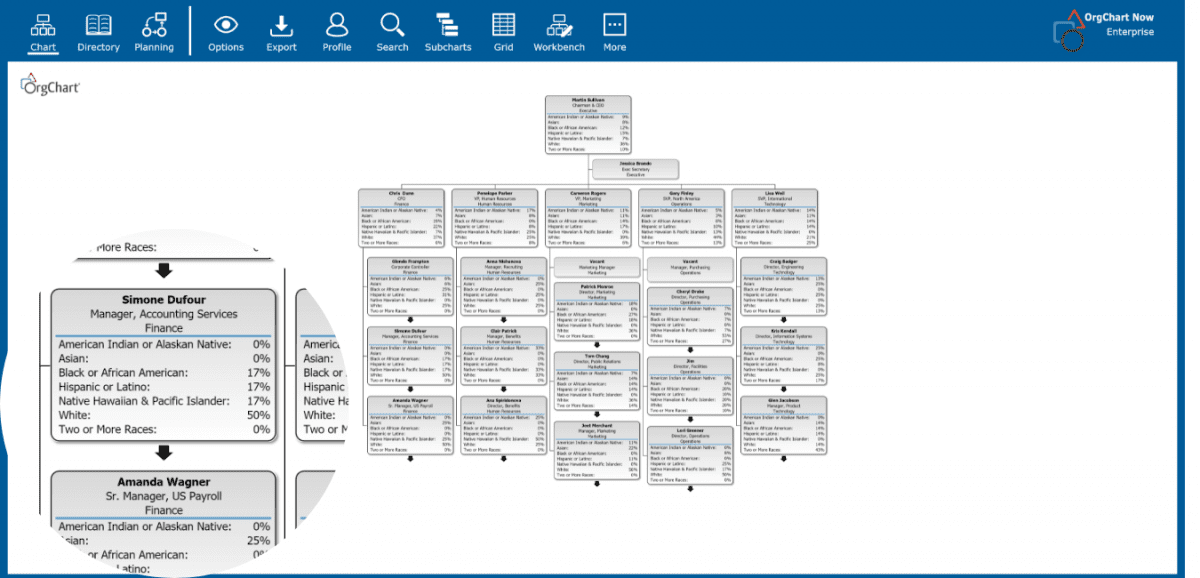May 19, 2021
12:09 AM
By OrgChart Team

For the better, the topics of diversity and equity are at center stage of the corporate world right now. The conversation has been simmering for decades but came to a noticeable boiling point in recent years with the prominent deaths of Black people, attacks against the Asian Americans, the lack of women in executive positions and the glaring imbalance inside corporate America.
The case for ethnic diversity and inclusion at all levels of any company can easily be made. Simply look at flash points from the most successful companies that stumbled trying to deliver complex messages about racial justice and the fight for representation. A soft drink is not the answer to police brutality against black people. And soap doesn’t need to tell women of color she can become white woman.
The case for ethnic diversity does not just stop at preventing public relation gaffes. A 2020 report from global consulting agency McKinsey showed that, from a financial perspective, companies that create action and follow through with diversity initiatives are more likely to out-earn their peers. But creating and following through to shape ethnically diverse organizations goes beyond a better bottom line. A workforce with individuals from a host of backgrounds leads to a broader range of experiences that give way to innovations and deeper insights.
“Diverse teams are more innovative — stronger at anticipating shifts in consumer needs and consumption patterns that make new products and services possible, potentially generating a competitive edge,” according to the McKinsey report.
Initiatives should and need to be genuine efforts to drive initiatives. Robin J. Ely, an American economist who is the Diane Doerge Wilson Professor of Business Administration at Harvard Business School, writes that employees question an organization’s intent when said organization simply emphasizes the economic payoff of diversity. More importantly, when companies tie the success to diversity initiatives to financial success, those initiatives are likely to fade when the gain is not delivered.
There is no silver bullet when it comes to creating initiatives to promote diversity. Companies are being encouraged to step back and examine their shortcomings when it comes to ethnic diversity. Leaders ought to investigate their work culture and see where there are opportunities. Not only to be more inclusive but to celebrate diversity.
Keeping the focus on inclusion became even more important in the wake of a pandemic year where broad industries saw shifts in their operations and means of communication. Companies struggled to adjust to the new ways of working and some even scaled back their workforce. These moves at companies both large and small had the potential to erode inclusion, according to the report by McKinsey.
Biases and exclusive behavior might have become more reinforced with the new way of working. Lines of communication, already difficult while working side-by-side with someone, were likely to become more difficult as teams and employees adapted to working remotely.
“Isolation leads to uncertainty about whom to talk with on specific issues and how and when to approach colleagues, leading to hold-ups and delays. In such a climate, there is a risk of amplifying non inclusive dynamics,” the McKinsey report reads.
As the pandemic begins to subside in parts of the world, companies should take the transition period to re-examine the road map to a more ethnically diverse organization. Companies should begin to examine how and when they can become stronger through a more diverse workforce. Companies need to leverage the data and insights already on hand when making these important decisions.

OrgChart Now chart showing the breakdown of ethnicity for each manager of an organization
OrgChart Now the leading cloud org chart software can present details on a company’s ethnic diversity in a clear, visual format. Equally, the charts can be broken into subcharts to be shared with stakeholders to identify areas of weakness in the organization. Desired future states of the organization can be modelled to help with planning and goal setting and key metrics, such as salary, can be added for a richer picture of any company. Using OrgChart Now software to model the ethnic diversity of an organization is a first step toward reaping the benefits of a more diverse workforce. If you want to know more about how to represent the diversity of your organization in a cloud org chart, schedule a consultation with one of our experts today.
Tags: